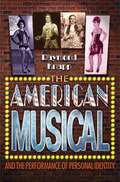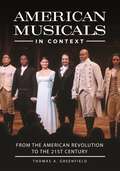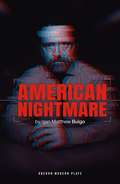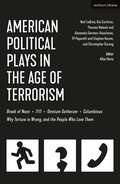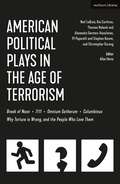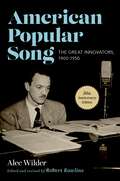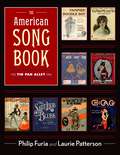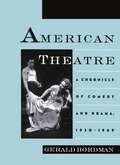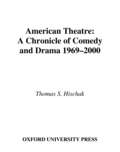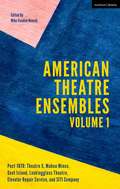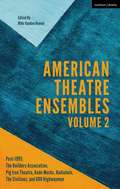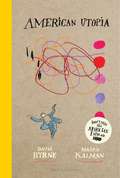- Table View
- List View
The American Musical and the Performance of Personal Identity
by Raymond KnappThe American musical has long provided an important vehicle through which writers, performers, and audiences reimagine who they are and how they might best interact with the world around them. Musicals are especially good at this because they provide not only an opportunity for us to enact dramatic versions of alternative identities, but also the material for performing such alternatives in the real world, through songs and the characters and attitudes those songs project. This book addresses a variety of specific themes in musicals that serve this general function: fairy tale and fantasy, idealism and inspiration, gender and sexuality, and relationships, among others. It also considers three overlapping genres that are central, in quite different ways, to the projection of personal identity: operetta, movie musicals, and operatic musicals. Among the musicals discussed are Camelot, Candide; Chicago; Company; Evita; Gypsy; Into the Woods; Kiss Me, Kate; A Little Night Music; Man of La Mancha; Meet Me in St. Louis; The Merry Widow; Moulin Rouge; My Fair Lady; Passion; The Rocky Horror Picture Show; Singin' in the Rain; Stormy Weather; Sweeney Todd; and The Wizard of Oz. Complementing the author's earlier work, The American Musical and the Formation of National Identity, this book completes a two-volume thematic history of the genre, designed for general audiences and specialists alike.
The American Musical and the Performance of Personal Identity
by Raymond KnappThe American musical has long provided an important vehicle through which writers, performers, and audiences reimagine who they are and how they might best interact with the world around them. Musicals are especially good at this because they provide not only an opportunity for us to enact dramatic versions of alternative identities, but also the material for performing such alternatives in the real world, through songs and the characters and attitudes those songs project. This book addresses a variety of specific themes in musicals that serve this general function: fairy tale and fantasy, idealism and inspiration, gender and sexuality, and relationships, among others. It also considers three overlapping genres that are central, in quite different ways, to the projection of personal identity: operetta, movie musicals, and operatic musicals. Among the musicals discussed are Camelot, Candide; Chicago; Company; Evita; Gypsy; Into the Woods; Kiss Me, Kate; A Little Night Music; Man of La Mancha; Meet Me in St. Louis; The Merry Widow; Moulin Rouge; My Fair Lady; Passion; The Rocky Horror Picture Show; Singin' in the Rain; Stormy Weather; Sweeney Todd; and The Wizard of Oz. Complementing the author's earlier work, The American Musical and the Formation of National Identity, this book completes a two-volume thematic history of the genre, designed for general audiences and specialists alike.
American Musicals in Context: From the American Revolution to the 21st Century
by Thomas A. GreenfieldAmerican Musicals in Context: From the American Revolution to the 21st Century gives students a fresh look at history-based musicals, helping readers to understand the American story through one of the country's most celebrated art forms: the musical.With the hit musical Hamilton (2015) captivating audiences and reshaping the way early U.S. history is taught and written about, this book offers insight into an array of musicals that explore U.S. history. The work provides a synopsis, overview of critical and audience reception, and historical context and analysis for each of 20 musicals selected for the unique and illuminating way they present the American story on the stage.Specifically, this volume explores musicals that have centered their themes, characters, and plots on some aspect of America's complex and ever-changing history. Each in its own way helps us rediscover pivotal national crises, key political decisions, defining moral choices, unspeakable and unresolved injustices, important and untold stories, defeats suffered, victories won in the face of monumental adversity, and the sacrifices borne publicly and privately in the process of creating the American narrative, one story at a time. Students will come away from the volume armed with the critical thinking skills necessary to discern fact from fiction in U.S. history.
American Musicals in Context: From the American Revolution to the 21st Century
by Thomas A. GreenfieldAmerican Musicals in Context: From the American Revolution to the 21st Century gives students a fresh look at history-based musicals, helping readers to understand the American story through one of the country's most celebrated art forms: the musical.With the hit musical Hamilton (2015) captivating audiences and reshaping the way early U.S. history is taught and written about, this book offers insight into an array of musicals that explore U.S. history. The work provides a synopsis, overview of critical and audience reception, and historical context and analysis for each of 20 musicals selected for the unique and illuminating way they present the American story on the stage.Specifically, this volume explores musicals that have centered their themes, characters, and plots on some aspect of America's complex and ever-changing history. Each in its own way helps us rediscover pivotal national crises, key political decisions, defining moral choices, unspeakable and unresolved injustices, important and untold stories, defeats suffered, victories won in the face of monumental adversity, and the sacrifices borne publicly and privately in the process of creating the American narrative, one story at a time. Students will come away from the volume armed with the critical thinking skills necessary to discern fact from fiction in U.S. history.
American Next Wave: Four Contemporary Plays from the HighTide Festival (Play Anthologies)
by Stella Fawn Ragsdale Mona Mansour Laura Marks Branden Jacob-JenkinsA collection of four plays by new American writers curated from the Emerging Writers Group at the Public Theater, New York. These plays represent the finest works developed by the Public Theater, addressing contemporary social preoccupations: race, class, heritage, economic hardship, family values and identity.The plays included are: Perish by Stella Fawn Ragsdale: when Porter's father kidnaps her son, she must go back to the woods of East Tennessee to find him, where she is distracted by a mysterious firebird. Textured with poetry and grit, this play follows the plight of women in Appalachia and the disappearance of the working class.The Hour of Feeling by Mona Mansour: in 1967, fuelled by a love of English Romantic poetry, a young Palestinian academic, Adham, and his new wife, Abir, take a trip to London, where he will deliver a career defining lecture. While the situation in his home "country" deteriorates and his marriage threatens to dissolve, Adham confronts his fear of failure and the reality that he may be an outsider no matter where he goes.Bethany by Laura Marks: when the going gets tough, the tough get going, and the going has gotten very tough indeed for Crystal. Her job is in jeopardy, her house has been repossessed and her daughter taken by social services. It's time for Crystal to get going. But in her effort to get her daughter back and put her life on the right track, Crystal is forced to question just how far she's willing to go to survive.Neighbors by Branden Jacobs-Jenkins: Black face, not on my doorstep, not today. Richard Patterson is not happy. The family of black actors that has moved in next door is rowdy, tacky, shameless, and uncouth. And they are not just invading his neighborhood-they're infiltrating his family, his sanity, and his entirely post-racial lifestyle. This wildly theatrical, explosive play on race is an unconventional comedy which uses minstrelsy both to explore the history of black theater and to confront tensions in 'post-racial' America.
American Next Wave: Four Contemporary Plays from the HighTide Festival (Play Anthologies)
by Stella Fawn Ragsdale Mona Mansour Laura Marks Branden Jacob-JenkinsA collection of four plays by new American writers curated from the Emerging Writers Group at the Public Theater, New York. These plays represent the finest works developed by the Public Theater, addressing contemporary social preoccupations: race, class, heritage, economic hardship, family values and identity.The plays included are: Perish by Stella Fawn Ragsdale: when Porter's father kidnaps her son, she must go back to the woods of East Tennessee to find him, where she is distracted by a mysterious firebird. Textured with poetry and grit, this play follows the plight of women in Appalachia and the disappearance of the working class.The Hour of Feeling by Mona Mansour: in 1967, fuelled by a love of English Romantic poetry, a young Palestinian academic, Adham, and his new wife, Abir, take a trip to London, where he will deliver a career defining lecture. While the situation in his home "country" deteriorates and his marriage threatens to dissolve, Adham confronts his fear of failure and the reality that he may be an outsider no matter where he goes.Bethany by Laura Marks: when the going gets tough, the tough get going, and the going has gotten very tough indeed for Crystal. Her job is in jeopardy, her house has been repossessed and her daughter taken by social services. It's time for Crystal to get going. But in her effort to get her daughter back and put her life on the right track, Crystal is forced to question just how far she's willing to go to survive.Neighbors by Branden Jacobs-Jenkins: Black face, not on my doorstep, not today. Richard Patterson is not happy. The family of black actors that has moved in next door is rowdy, tacky, shameless, and uncouth. And they are not just invading his neighborhood-they're infiltrating his family, his sanity, and his entirely post-racial lifestyle. This wildly theatrical, explosive play on race is an unconventional comedy which uses minstrelsy both to explore the history of black theater and to confront tensions in 'post-racial' America.
American Nightmare (Oberon Modern Plays)
by Matthew Bulgo“It’s chaos out there. Not that I’m complaining. Lotta profit in chaos.” High above New York City, the super-rich wine and dine in sky-line restaurants dreaming of bigger and better cities. In a military bunker deep in the heart of an American wasteland, the poor compete for food and preferment in a programme with more than sinister ends. What happens when the rift between the haves and the have-nots becomes unassailable? Matthew Bulgo's new intellectual thriller American Nightmare dissects the battle lines that exist within the eponymous ‘American Dream’.
The American Pilot: Outlying Island - San Diego - The American Pilot - Pyrenees - Kyoto - Being Norwegian
by David GreigA spy plane crash-lands in a remote valley in a distant country. The local villagers take in the wounded pilot and argue his fate. The American Pilot explores the way the world sees America and the way America sees the world.The American Pilot premiered with the RSC at The Other Place, Stratford-upon-Avon in April 2005.'Greig at his best.' Evening Standard.'One of the most intellectually stimulating dramatists around... A richly provocative new play.' Guardian'The sheer brilliance of Greig, storyteller and seer.' Herald.The American Pilot premiered with the RSC at The Other Place, Stratford Upon Avon, in April 2005.
American Playwriting and the Anti-Political Prejudice: Twentieth- and Twenty-First-Century Perspectives (Palgrave Studies in Theatre and Performance History)
by N. PressleyTwenty years after Tony Kushner's influential Angels in America seemed to declare a revitalized potency for the popular political play, there is a "No Politics" prejudice undermining US production and writing. This book explores the largely unrecognized cultural patterns that discourage political playwriting on the contemporary American stage.
American Political Plays in the Age of Terrorism: Break of Noon; 7/11; Omnium Gatherum; Columbinus; Why Torture is Wrong, and the People Who Love Them
by Neil LaBute Kia Corthron Theresa Rebeck Alexandra Gersten-Vassilaros Stephen Karam PJ Paparelli Christopher DurangThis powerful anthology brings together reflective and raw plays by American playwrights surrounding the psychic and political boundaries of the many faces and shadows of terrorism. Allan Havis's introduction addresses a variety of terrorism cases from the last 25 years, examines several theories of the root causes of modern terrors, and underscores how theatre forms a unique contour to social and philosophical thought on terrorism. With a foreword from Robert Brustein, the anthology features: Break of Noon by Neil LaBute7/11 by Kia CorthronOmnium Gatherum by Theresa Rebeck and Alexandra Gersten-VassilarosColumbinus by PJ Paparelli and Stephen KaramWhy Torture is Wrong, and the People Who Love Them by Christopher Durang
American Political Plays in the Age of Terrorism: Break of Noon; 7/11; Omnium Gatherum; Columbinus; Why Torture is Wrong, and the People Who Love Them
by Neil LaBute Kia Corthron Theresa Rebeck Alexandra Gersten-Vassilaros Stephen Karam PJ Paparelli Christopher DurangThis powerful anthology brings together reflective and raw plays by American playwrights surrounding the psychic and political boundaries of the many faces and shadows of terrorism. Allan Havis's introduction addresses a variety of terrorism cases from the last 25 years, examines several theories of the root causes of modern terrors, and underscores how theatre forms a unique contour to social and philosophical thought on terrorism. With a foreword from Robert Brustein, the anthology features: Break of Noon by Neil LaBute7/11 by Kia CorthronOmnium Gatherum by Theresa Rebeck and Alexandra Gersten-VassilarosColumbinus by PJ Paparelli and Stephen KaramWhy Torture is Wrong, and the People Who Love Them by Christopher Durang
American Popular Song: The Great Innovators, 1900-1950
by Alec Wilder"Wonderful"--The New York Times. "Provocative, opinionated, and never dull"--Down Beat. "A singular book."--Studs Terkel. When it was first published, Alec Wilder's American Popular Song quickly became a classic and today it remains essential reading for countless musicians, lovers of American Song, and fans of Alec Wilder. Now, in a 50th anniversary edition, popular music scholar Robert Rawlins brings the book fully up-to-date for the 21st century. Whereas previous editions featured only piano scores, the format has been changed to lead sheet notation with lyrics, making it accessible to a wider readership. Rawlins has also added more than sixty music examples to help complete the chapter on Irving Berlin. One of the most fascinating features of the original edition was Wilder's inventive use of language, often revealing his strong and sometimes irreverent opinions. Wilder's prose remains relatively unaltered, but footnotes have been provided that clarify, elucidate, and even correct. Moreover, a new chapter has been added, discussing fifty-three songs by numerous composers that Wilder might have well included but was not able to. Songs by Ann Ronnell, Fats Waller, Jule Styne and many others are capped off with an examination of ten of Wilder's own songs.
American Popular Song: The Great Innovators, 1900-1950
by Alec Wilder"Wonderful"--The New York Times. "Provocative, opinionated, and never dull"--Down Beat. "A singular book."--Studs Terkel. When it was first published, Alec Wilder's American Popular Song quickly became a classic and today it remains essential reading for countless musicians, lovers of American Song, and fans of Alec Wilder. Now, in a 50th anniversary edition, popular music scholar Robert Rawlins brings the book fully up-to-date for the 21st century. Whereas previous editions featured only piano scores, the format has been changed to lead sheet notation with lyrics, making it accessible to a wider readership. Rawlins has also added more than sixty music examples to help complete the chapter on Irving Berlin. One of the most fascinating features of the original edition was Wilder's inventive use of language, often revealing his strong and sometimes irreverent opinions. Wilder's prose remains relatively unaltered, but footnotes have been provided that clarify, elucidate, and even correct. Moreover, a new chapter has been added, discussing fifty-three songs by numerous composers that Wilder might have well included but was not able to. Songs by Ann Ronnell, Fats Waller, Jule Styne and many others are capped off with an examination of ten of Wilder's own songs.
The American Song Book: The Tin Pan Alley Era
by Philip Furia Laurie J. PattersonThe American Song Book, Volume I: The Tin Pan Alley Era is the first in a projected five-volume series of books that will reprint original sheet music, including covers, of songs that constitute the enduring standards of Irving Berlin, Jerome Kern, the Gershwins, and other lyricists and composers of what has been called the "Golden Age" of American popular music. These songs have done what popular songs are not supposed to do-stayed popular. They have been reinterpreted year after year, generation after generation, by jazz artists such as Charlie Parker and Art Tatum, Ella Fitzgerald and Louis Armstrong. In the 1950s, Frank Sinatra began recording albums of these standards and was soon followed by such singers as Tony Bennet, Doris Day, Willie Nelson, and Linda Ronstadt. In more recent years, these songs have been reinterpreted by Rod Stewart, Harry Connick, Jr., Carly Simon, Lady GaGa, K.D. Laing, Paul McCartney, and, most recently, Bob Dylan. As such, these songs constitute the closest thing America has to a repertory of enduring classical music. In addition to reprinting the sheet music for these classic songs, authors Philip Furia and Laurie Patterson place these songs in historical context with essays about the sheet-music publishing industry known as Tin Pan Alley, the emergence of American musical comedy on Broadway, and the "talkie" revolution that made possible the Hollywood musical. The authors also provide biographical sketches of songwriters, performers, and impresarios such as Florenz Ziegfeld. In addition, they analyze the lyrical and musical artistry of each song and relate anecdotes, sometimes amusing, sometimes poignant, about how the songs were created. The American Songbook is a book that can be read for enjoyment on its own or be propped on the piano to be played and sung.
American Theatre: A Chronicle of Comedy and Drama, 1930-1969
by Gerald BordmanThis book concludes Gerald Bordman's acclaimed survey of American non-musical theatre. It deals with the years 1930 to 1970, a period when the number of yearly new plays was shrinking, but a period during which American drama as a whole entered the world stage and became a dominant force. With works like Eugene O'Neill's Long Day's Journey Into Night, Tennessee William's A Streetcar Named Desire, and Arthur Miller's Death of a Salesman, American theater finally reached adulthood both dramatically and psychologically. Bordman's lively, authoritative study covers every Broadway production, as well as every major off-Broadway show. His discussion moves season by season and show by show in chronological order; he offers plot synopses and details the physical production, directors, players, theaters, and newspaper reviews. This book and the preceding volumes of American Theatre stand as the premier history of American drama.
American Theatre: A Chronicle of Comedy and Drama, 1969-2000
by Thomas S. HischakVolume Four of the distinguished American Theatre: A Chronicle of Comedy and Drama series offers a thorough, candid, and fascinating look at the theater in New York during the last decades of the twentieth century.
American Theatre: History, Context, Form (Baas Paperbacks Ser.)
by Theresa SaxonArgues for the recognition of American theatre history as long, rich, diverse and critically compelling. Embracing all epochs of theatre history, from pre-colonial Native American performance rituals and the endeavours of early colonisers in the sixteenth and seventeenth centuries, to the end of the twentieth century, Theresa Saxon situates American theatre as a lively, dynamic and diverse arena. She considers the implications of political manoeuvrings, economics - state-funding and commercial enterprises - race and gender, as well as material factors such as technology, riot and fire, as major forces in determining the structure of America's playhouses and productions. She goes on to investigate critical understandings of the term 'theatre,' and assesses ways in which the various values of commerce, entertainment, education and dramatic production have informed the definition of theatre throughout America's history.
American Theatre: History, Context, Form (BAAS Paperbacks)
by Theresa SaxonThis book provides a brief yet informative evaluation of the variety and complexity of theatrical endeavours in the United States, embracing all epochs of theatre history and situating American theatre as a lively, dynamic and diverse arena.
American Theatre Ensembles Volume 1: Post-1970: Theatre X, Mabou Mines, Goat Island, Lookingglass Theatre, Elevator Repair Service, and SITI Company
by Mike Vanden HeuvelAcross two volumes, Mike Vanden Heuvel and a strong roster of contributors present the history, processes, and achievements of American theatre companies renowned for their use of collective and/or ensemble-based techniques to generate new work. This first study considers theatre companies that were working between 1970 and 1995: it traces the rise and eventual diversification of activist-based companies that emerged to serve particular constituencies from the countercultural politics of the 1960s, and examines the shift in the 1980s that gave rise to the next generation of company-based work, rooted in a new interest in form and the more mediated and dispersed forms of politics. Ensembles examined are Mabou Mines, Theatre X, Goat Island, Lookingglass, Elevator Repair Service, and SITI Company.Preliminary chapters provide a sweeping overview of ensemble-based creation within the general historical and cultural contexts of the period, followed by a detailed study of the evolution of ensemble-based work. The case studies consider factors such as influence, funding, production, and legacies, as well as the forms of collective devising and creation, while surveying the continuing work of significant long-running companies.Contributors provide detailed case studies of the 6 companies from the period and cover:* A chronicle of development and methods* Key productions and projects* Critical reception and legacy* A chronological overview of significant productionsFrom the long history of collective theatre creation, with its sources in social crises, urgent aesthetic experimentation and utopian dreaming, American ensemble-based theatre has emerged at several key points in history to challenge the primacy of author-based and director-produced theatre. As the volume demonstrates, US ensemble companies have collectively revolutionized the form and content of contemporary performance, influencing experimental, as well as mainstream practice.
American Theatre Ensembles Volume 1: Post-1970: Theatre X, Mabou Mines, Goat Island, Lookingglass Theatre, Elevator Repair Service, and SITI Company
Across two volumes, Mike Vanden Heuvel and a strong roster of contributors present the history, processes, and achievements of American theatre companies renowned for their use of collective and/or ensemble-based techniques to generate new work. This first study considers theatre companies that were working between 1970 and 1995: it traces the rise and eventual diversification of activist-based companies that emerged to serve particular constituencies from the countercultural politics of the 1960s, and examines the shift in the 1980s that gave rise to the next generation of company-based work, rooted in a new interest in form and the more mediated and dispersed forms of politics. Ensembles examined are Mabou Mines, Theatre X, Goat Island, Lookingglass, Elevator Repair Service, and SITI Company.Preliminary chapters provide a sweeping overview of ensemble-based creation within the general historical and cultural contexts of the period, followed by a detailed study of the evolution of ensemble-based work. The case studies consider factors such as influence, funding, production, and legacies, as well as the forms of collective devising and creation, while surveying the continuing work of significant long-running companies.Contributors provide detailed case studies of the 6 companies from the period and cover:* A chronicle of development and methods* Key productions and projects* Critical reception and legacy* A chronological overview of significant productionsFrom the long history of collective theatre creation, with its sources in social crises, urgent aesthetic experimentation and utopian dreaming, American ensemble-based theatre has emerged at several key points in history to challenge the primacy of author-based and director-produced theatre. As the volume demonstrates, US ensemble companies have collectively revolutionized the form and content of contemporary performance, influencing experimental, as well as mainstream practice.
American Theatre Ensembles Volume 2: Post-1995: The Builders Association, Pig Iron Theatre, Rude Mechs, Radiohole, The Civilians, and 600 Highwaymen
by Mike Vanden HeuvelA companion to American Theatre Ensembles Volume 1, this volume charts the development and achievements of theatre companies working after 1995, bringing together the diffuse generation of ensembles working within a context of media saturation and epistemological and social fragmentation. Ensembles examined include Rude Mechs, The Builders Association, Pig Iron, Radiohole, The Civilians and 600 Highwaymen.Introductory chapters provide a sweeping overview of ensemble-based creation within the general historical and cultural contexts of the period, followed by a detailed study of the evolution of ensemble-based work. Contributors examine matters such as influence, funding, production and legacies, as well as the forms of collective devising and creation, while presenting close readings of the companies' most prominent works.The volume features detailed case studies of the 6 companies from the period and cover: * A history of development and methods * Key productions and projects* Critical reception * A chronology of significant productions US ensemble companies since 1995 have revolutionized the form and content of contemporary performance, influencing experimental as well as mainstream practice. This volume provides the first encompassing study of this vital development in contemporary American theatre by mapping its evolution and key developments.
American Theatre Ensembles Volume 2: Post-1995: The Builders Association, Pig Iron Theatre, Rude Mechs, Radiohole, The Civilians, and 600 Highwaymen
A companion to American Theatre Ensembles Volume 1, this volume charts the development and achievements of theatre companies working after 1995, bringing together the diffuse generation of ensembles working within a context of media saturation and epistemological and social fragmentation. Ensembles examined include Rude Mechs, The Builders Association, Pig Iron, Radiohole, The Civilians and 600 Highwaymen.Introductory chapters provide a sweeping overview of ensemble-based creation within the general historical and cultural contexts of the period, followed by a detailed study of the evolution of ensemble-based work. Contributors examine matters such as influence, funding, production and legacies, as well as the forms of collective devising and creation, while presenting close readings of the companies' most prominent works.The volume features detailed case studies of the 6 companies from the period and cover: * A history of development and methods * Key productions and projects* Critical reception * A chronology of significant productions US ensemble companies since 1995 have revolutionized the form and content of contemporary performance, influencing experimental as well as mainstream practice. This volume provides the first encompassing study of this vital development in contemporary American theatre by mapping its evolution and key developments.
American Trade
by Tarell Alvin McCraneyWhen life in New York gets to hot to handle, charismatic hustler Pharus escapes the clutches of rap star Jules and moves to London. A funny, uncompromising about surviving in the big city that challenges our assumptions about racial and sexual identity, American Trade celebrates twenty-first-century London in all its extravagant diversity.Tarell Alvin McCraney's American Trade premiered at the Hampstead Theatre, London, in June 2011 in a production by the Royal Shakespeare Company.
American ‘Unculture’ in French Drama: Homo Americanus and the Post-1960 French Resistance
by Les EssifA book about the role America plays in the French imagination, as it translates to the French stage. Informed by a rich variety of Western cultural scholarship, Essif examines two dozen post-1960 works representing some of the most innovative dramaturgy of the last half century, including works by Gatti, Obaldia, Cixous, Koltes, and Vinaver.
American Utopia
by Maira Kalman David ByrneFrom former Talking Heads frontman and multimedia visionary David Byrne and revered bestselling author, illustrator, and artist Maira Kalman--an inspiring celebration in words and art of the connections between us all. Don't miss the Spike Lee film of the Broadway hit American Utopia--on HBO.A joyful collaboration between old friends David Byrne and Maira Kalman, American Utopia offers readers an antidote to cynicism, bursting with pathos, humanism, and hope--featuring his words and lyrics brought to life with more than 150 of her colorful paintings.The text is drawn from David Byrne's American Utopia, which has become a hit Broadway show and is soon to be a documentary from Spike Lee. The four-color artwork, by Maira Kalman, which she created for the Broadway show's curtain, is composed of small moments, expressions, gestures, and interactions that together offer a portrait of daily life and coexistence.With their creative talents combined, American Utopia is a salvo for kindness and a call for jubilation, a reminder to sing, dance, and waste not a moment. Beautifully designed and edited by Alex Kalman, American Utopia is a balm for the soul from two of the world's most extraordinary artists.
